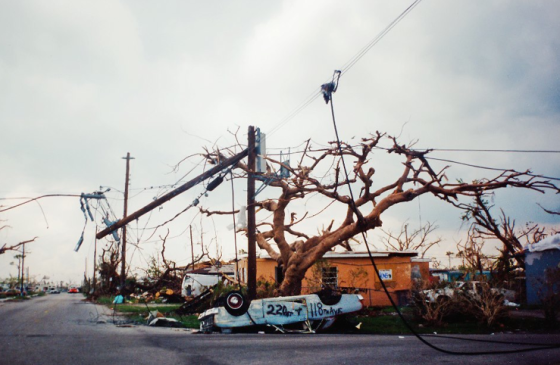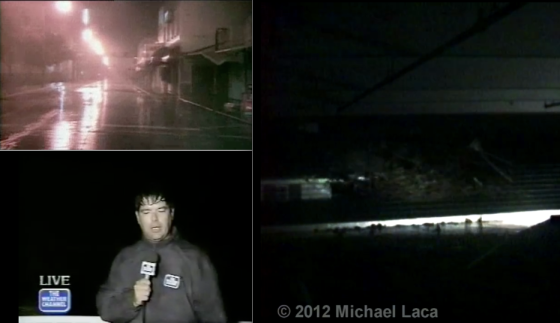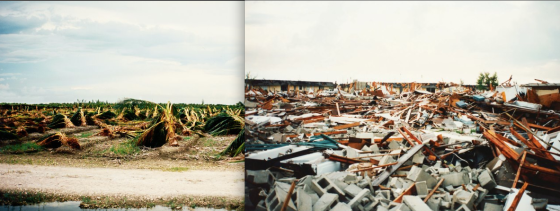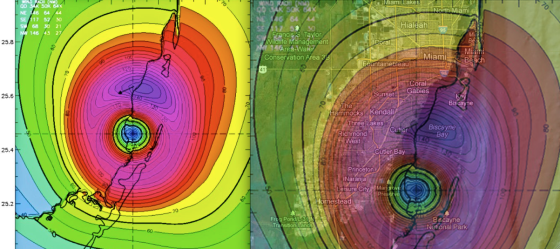
Cyclone Tracy devastated the city of Darwin on Christmas Day, 1974. The storm caused more wind-related fatalities than any other tropical cyclone in a developed nation since 1950 and nearly led to the abandonment of half the city.
□ The city of Darwin, which sits alone atop Australia’s northern coastline, experienced a large surge of development in the years following World War II. Despite the existence of fairly standard building regulations, much of the city and its suburbs were constructed quickly in the 50’s and 60’s, causing many developers to turn a blind eye to the structural codes (Risk Assessment Model). As the city had not experienced a severe cyclone in many decades, the new suburban neighborhoods were built primarily with the tropical heat in mind. To take advantage of afternoon breezes, homes were elevated atop cement pillars and fitted with louvres for ventilation. By 1970, more than 40,000 people called the growing city home.
On December 22nd, 1974, a swirling mass of rain entered within range of the Darwin radar. The storm, named Cyclone Tracy the previous evening, appeared small and meek as it spun ever so slowly to the southwest. False alarms were commonplace in the tropics, and few paid much attention to radio warnings as the cyclone changed direction and slowly moved into the Beagle Gulf. Cyclone Tracy was an exceptionally small storm, being able to fit entirely within the 40 mile wedge between Bathurst Island and mainland Australia.

Composite radar view of Cyclone Tracy on the evening of December 24th, with the city of Darwin highlighted in yellow. The eyewall surrounding the storm is unusually compact and symmetrical. Despite the center of the storm being a mere 15 miles from Darwin, the city was experiencing only moderate rain and breezy conditions. The most intense winds in the cyclone extended only a few miles beyond the edge of the eye.
Cyclone alerts warned that “very destructive winds” of 75mph (120 km/h) with gusts to 94mph (150 km/h) were expected to hit the area late Christmas Eve. Many residents boarded up their windows while some chose to wait-and-see with the impending storm, which was forecast to be of only moderate intensity – the equivalent of a minimal Category 1 hurricane in the Atlantic.
Only a dozen miles offshore, the eye of Cyclone Tracy contracted to less than seven miles in width. The storm would become the smallest tropical cyclone in history, with winds over 38mph (60 km/h) extending only 30 miles from the center of the storm, and hurricane force winds extending less than eight miles.* Unbeknownst to meteorologists at the time, the storm had significantly stronger winds than originally estimated, and was gaining intensity as darkness fell over Darwin the night of Christmas Eve.
*Tropical Storm Marco in 2008 became the smallest tropical cyclone in history, with gale force winds extending only 10 miles from its center. The storm was significantly weaker, however. No storm of greater intensity has ever approached the tiny diameter of Cyclone Tracy..
The Storm
Winds picked up across Darwin shortly after 11pm as a few brave holiday partygoers left city pubs and headed home. By 12am Christmas morning, gusts of 50mph (80km/h) were being recorded at the Darwin Airport, and the winds were increasing with each passing minute. Around 1am, serious damage began to occur as hurricane force gusts reached the coastline.
Convection surrounding Tracy’s pinpoint eye intensified throughout the night, causing the storm’s central pressure to drop to 950mb, or perhaps a bit lower. Later analysis concluded that Cyclone Tracy entered a period of “explosive deepening” in the hours prior to making landfall, causing the storm’s eye to contract to only 5 miles in width (Sydney Morning Herald, 1975). The cyclone’s extremely slow forward pace, under 5mph, meant that sections of Darwin were to experience hurricane force winds for more than three hours.

Wind trace from the Darwin Airport, located three miles inland and near the center of the storm’s path. Winds rapidly increased after 2:30am as the powerful eyewall came shore. A peak gust of 135mph (217 km/h) was recorded just before the anemometer failed at 3:10am. The failure likely coincided with the commencement of the storm’s highest winds, which likely intensified before the calm of the eye reached the area 40 minutes later. A false reading was created at the end of the trace as the instrument failed. (Mason and Haynes)

Severe damage at the RAAF base in Darwin. An Indonesian DC3 airplane, which had been anchored to multiple 44-gallon drums filled with concrete, was lifted and thrown completely over a nearby hangar (visible above). Many of the destroyed aircraft were later placed in the Darwin Air Museum as a memento to the cyclone. (RAAF)
Around 3am, homes near the coast began to experience the full force of Cyclone Tracy. Darwin residents, initially concerned with the damage to their homes, soon realized their lives were in danger. Just north of downtown, priest Ted Collins made a brief audio recording of the storm as it roared like a jet engine over town (best heard with headphones on high volume). Flying debris from thousands of disintegrating homes filled the air, puncturing boarded windows and banging loudly against the sides of homes. Terrified residents huddled in their bathrooms as their homes shook violently amidst the thundering winds. Slightly south of the worst conditions, a survivor from Fannie Bay described her experience:
One of the living room windows went. And, shortly thereafter, the louvers burst in the bedrooms. Next, I saw the hatch to the attic pop up, so I knew the roof was going. You could hear the tin being torn from the roof by the fierce wind…By this time the water was pouring through the windows and we were lying cold and wet. I could feel the movement of the floor under me and the shuttering of the house. (Gil Jennex)
Farther north, 17-year old Amanda White (nee Mills) was weathering the storm at her father’s home in Rapid Creek:
At one point the winds were so loud that it didn’t seem they could get any stronger. I could hear the roof being torn off, and then something large smashed through the bedroom wall and took some of the house along with it. Before I could get a good grip on the counter, the whole structure came apart. My arm was badly crushed from a piece of timber. All I felt I could do was pray that I wouldn’t feel any pain, if it took me or not.

Final view of Cyclone Tracy, around 5am, before the radar failed. The storm’s eye contracted to only 5 miles in width in the hours before landfall (Mason and Haynes, 2010). As the leading edge of the back eyewall began impacting the airport, the radar failed, effectively ending all local analysis of the storm.

Extreme wind damage in Casuarina, one of Darwin’s northern suburbs. Entire forests were stripped of leaves and branches by the storm, an indication of extreme intensity. (Image by Rick Stevens)
The eye provided a brief 40 minute respite, confusing many into thinking the storm had passed. Survivors described the back eyewall of the storm as even more fierce than the front, accompanied by a roar that was heard several minutes before the winds recommenced. Due to the storm’s slow speed, the severe nature of the “second wind” was unusual. Some researchers later concluded that the winds in the western eyewall may have appeared more intense due to the multitude of debris left behind by the first half of the storm. Others researchers believe the storm continued to intensify slightly after landfall. One study also concluded that “decreased fetch roughness” in the back eyewall may have led to their increased intensity in the northern suburbs (Mason and Haynes).
By daylight on Christmas Day, 71 people had been killed directly by the storm. Most of the 50 fatalities that occurred on land were in the northern suburbs, where the most extreme damage occurred. A detailed report on 46 of the fatalities concluded that 33 of the victims were crushed by collapsed buildings, and another 13 deaths were related to flying debris, mostly from slicing pieces of metal but also from “penetration” by flying timber. Injuries sustained from being blown out of elevated houses was also a contributing factor in some of the deaths (Mason and Haynes). In one instance, an injured man sought shelter in a neighbor’s home during the eye of the cyclone, only to be killed when the house was leveled in the second half of the storm.
Cyclone Tracy caused more wind related fatalities than any other tropical cyclone to impact the United States or Australia since the turn of the 20th century. Hurricane Andrew, which struck a more populated area as a Category 5 hurricane in 1992, caused only 14 wind-related deaths. The high number of victims is likely the result of four factors – the extreme intensity of the winds, the duration of the slow-moving cyclone, the building construction in the area and the lack of evacuation preceding the storm (Griffith Review).

Image of trees that were stripped of leaves and branches by Cyclone Tracy. Such damage is generally only seen in powerful tropical cyclones with wind gusts exceeding 150mph. (Northern Territory Library)

A bus at the RAAF base was flipped multiple times and crushed by Cyclone Tracy (RAAF).
Debate still exists over the exact strength of Tracy’s winds. Observations at the Darwin Airport indicated that sustained winds were rapidly intensifying when the instrument failed at 3:10am. According to the on-hand weather observers, the calm center reached the airport at 3:50am, so the 40 minutes preceding the eye, as well as the back eyewall of the cyclone, were not recorded. Therefore, it is probable that wind gusts significantly higher than 135mph affected the airport, which was south of the worst affected areas.
Another notable variable is the pressure gradient of the cyclone. Observations in northern Darwin indicate that Tracy had a pressure gradient of 5.5mb per kilometer, or 8.8mb per mile (Courtney and Knaff, 2008). Such a steep gradient is comparable to some of the most intense Category 5 hurricanes in the Atlantic. While the central pressure of the storm was likely somewhere between 946 and 950mb, typical of a strong Category 3 hurricane in the Atlantic, the storm’s small size compressed the pressure difference into an unusually small area.

At left, an apartment building that lost its upper floor. At right, a devastated home in Rapid Creek.
The official report following the cyclone estimated peak gusts reached 150mph, or 240 km/h (Bureau of Meteorology Report). A more recent study suggests that maximum gusts were more likely around 162mph, or 260 km/h (Mason and Haynes). Some unofficial estimates place the highest gusts at 185mph (300 km/h) (Sydney Morning Herald, 1975). Considering the severity of the damage, including dozens of flipped vehicles and the deformation of thick steel beams, it is probable that many locations experienced gusts greater than 160mph.
A number of meteorologists have suggested that vortices imbedded in the storm’s eyewall (later identified as “miniswirls” following Hurricane Andrew in 1992) may have been responsible for some of the more extreme damage. Evidence pointing to the existence of violent, small-scale wind features included a refrigerator that was found imbedded in the side of a water tower 50ft above the ground (Sydney Morning Herald, 1975). Pilots in the area also sighted tornadic vortices within the storm.
Cyclone Tracy officially remains a Category 4 on the Australian Cyclone Scale, with sustained winds between 100mph and 123mph. The damage caused by the storm, however, suggests that the cyclone was significantly more intense.

Vehicles flipped by Cyclone Tracy. The car at distance appears to have been tossed from a parking stall, perhaps as far as 20ft. There does not appear to be any nearby wall which could have provided upward lift, as is commonly the case when cars are moved by hurricanes. A recent study that placed vehicles in wind tunnels concluded that winds of 150 to 180mph were required to overturn minivans at less “sensitive” angles (Lyons, 2009).
















